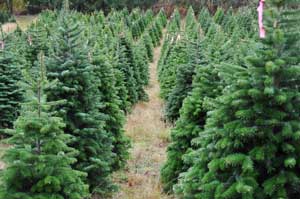A Quick History of the Christmas Tree Industry
For those who erect a large evergreen in their living room every December, some like the convenience, look and predictability of an artificial tree. But others are passionate about the appearance, smell and needles of a real tree.

Thinkstock/Evan Sharboneau
The exact origins of the Christmas tree industry are a mystery, as noted a 1971 article in the Business Review (a now-retired publication by the Federal Reserve Bank of Philadelphia). Some historians trace the tradition of bringing a real evergreen home for Christmas to the year 1500.
The tradition evolved from cutting down a tree in the forest to a time when the demand for Christmas trees outgrew the wild supplies. That’s when individuals went into business growing Christmas trees as a cash crop.
Real Trees Need TLC
In the Business Review article, “About Christmas Trees,” author Evan B. Alderfer told a holiday tale about the evolution of the tree-farming industry.
He noted that the first national survey of Christmas trees was performed in 1948, with about 85 percent of the 21 million Christmas trees being grown in the wild. By the article’s 1971 publication, about half of Christmas trees were grown as a cash crop.
But even in the 1970s, the industry was not without challenges. The author described the potential perils of tree farming, from establishing seedlings to raising crooked crops and dealing with bugs.
“Growing Christmas trees as a cash crop looks like easy money,” he said, cautioning beginners not to underestimate the amount of “tender loving care and the length of time required before the cash rolls in.”
By the Numbers
Here’s a look at the Christmas tree industry circa 1971:
- About 45 million live trees sold
- Retail sales totaled more than $200 million
- More than 100,000 people employed, including retailers, distributors, seasonal workers and full-time employees
Here’s a comparison from 2016, according to the National Christmas Tree Association:
- 27 million live trees sold
- Retail sales totaled more than $2 billion
- More than 100,000 people employed full- or part-time in the industry
So, a festive tradition grew into an industry that adds up to thousands of jobs and millions of dollars every year.
More Holiday History
You can read Alderfer’s entire article in FRASER, the Federal Reserve Archival System for Economic Research. FRASER is the St. Louis Fed’s digital library of more than half a million speeches and statements, data and statistical publications, government documents, archival collections, photos, maps and books.
Check out even more holiday history from FRASER:
- Read “A Christmas Present for the President,” detailing politics around the creation of the Fed.
- See a 1920 holiday cable from New York Fed President Benjamin Strong.
- View a 1918 letter from the Federal Reserve Board warning against giving gold for Christmas after World War I.
This blog explains everyday economics and the Fed, while also spotlighting St. Louis Fed people and programs. Views expressed are not necessarily those of the St. Louis Fed or Federal Reserve System.
Email Us


